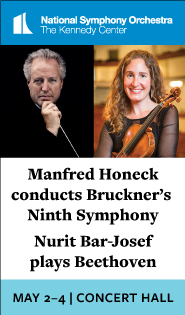New Constellations series goes back to nature in adventurous season opener

Scott Christian, Jeff Stern, and Sam Seyong Um (left to right) performed Sunday afternoon with Constellations Chamber Concerts. Photo: Steven Balis
In 2019, Constellations Chamber Concerts began presenting intimate concerts in private homes. This eclectic new series, led by artistic director and pianist Ellen Hwangbo, benefited in some ways from the pandemic, as it took its small concerts to broader audiences online.
Now Constellations is transitioning back to in-person performances, with an in-person season opener held Sunday afternoon in the backyard of a patron’s residence in Potomac.
Constellations takes advantage of its pop-up format to present surprising repertoire. This fascinating program for combinations of flute, guitar, and three percussionists, anchored by two musicians from the National Symphony Orchestra, is a stellar example. The music, supported by careful amplification engineered by David Angell, mixed in charming ways with the ambient noise of the outdoor setting, as birds and cicadas sang and butterflies floated by.
The concert opened with two subdued solo pieces, beginning with Sindo Garay’s Perla Marina. Guitarist Dieter Hennings gave a delicate, melancholic sheen to the Cuban songwriter’s work, in an arrangement by Rey Guerra that brought out polyphonic aspects. Aaron Goldman, the NSO’s principal flutist, followed with Debussy’s Syrinx, enhancing the piece’s mysterious qualities by starting to play from behind the audience and then continuing as he walked to the stage.
Symbolic of the emergence of musicians from lockdown, the two musicians joined forces for the “Nightclub, 1960” movement from Piazzolla’s Histoire du Tango. The duo excelled in the slow half of the paired dances, transparently balanced and moving together with an easy rubato. The faster sections bubbled vibrantly, if somewhat less elegantly.
Four pieces from Robert Beaser’s Mountain Songs, ingenious arrangements of Appalachian and southern folk tunes for flute and guitar, concluded the first half. Hennings and Goldman each had a turn with the first tune, “Barbara Allen,” and with each verse the harmony and instrumental interaction became more complex. Murmuring trills and immaculate high notes from Goldman enhanced the atmospheric mood.
Hennings ably provided more active accompaniment in “The House Carpenter,” with Goldman mostly floating above the fray on the tune. The tragic lullaby “Hush You Bye” was the highlight, matching the poignant melody with square accompaniment in intriguing harmonies. The final selection, “Quicksilver,” gave Hennings quite a workout in a gigue-like sprint not based on a pre-existing melody.
At the core of this program was George Crumb’s extended work An Idyll for the Misbegotten, in the original instrumentation for flute and three percussionists. The musicians enveloped the listeners in sound, with the percussionists stationed in an arc at the back of the audience in dialogue with Goldman on the stage. The central percussionist, Sam Seyong Um, heightened the tension with an almost-constant thunder-like roll on the bass drum.
Crumb envisioned that the piece should be “heard from afar, over a lake, on a moonlit evening in August,” a phrase that recalls the addition of the flute part to Charles Ives’s Concord Sonata. Goldman teased out the delicious allusions Crumb made to Debussy’s Syrinx, cleverly programmed earlier in the concert. The natural setting, as the vivid late-summer sunlight faded and a cool breeze stirred the air, provided just the sort of backdrop Crumb described. The other two percussionists, Jeff Stern and the NSO’s Scott Christian, volleyed rhythmic patter on tom-toms, bongos, and log drums back and forth from opposite sides of the space.
Hennings returned for the brief “Air” movement from Lou Harrison’s Serenade, a simple but beguiling melody in an unusual tuning. Um provided the optional percussion, adding a perplexing sonic edge with the sounds of a large gong. Hennings and Goldman, now on the dusky alto flute, were reunited one last time for the “Cape Cold” movement from Tōru Takemitsu’s evocative Toward the Sea. The more tonal, jazz-influenced idiom, with the flute’s insistence on the composer’s sea motif (E-flat, E-natural, A), hearkened back to the Piazzolla work.
The three percussionists enlivened the concert’s concluding moments with two electrifying pieces, both performed at percussion stands in the center of the audience space. On Mark Applebaum’s Catfish, from 1997, the trio of Christian, Stern, and Um sorted out the dizzying variety of patterns and meters with exemplary precision. The instruments selected—which the composer left up to the performers—gave the work a mellow, muted cast, combining conga drums with cowbells, muted on foam pads, and wood blocks.
The “Meccanico” movement from Nebojša Jovan Živković’s Trio per Uno provided an even more energetic conclusion. Making their way one by one to the center, the three percussionists came together around a bass drum, initially striking its rim with sticks. Leaning in, they then moved to the drumhead, coordinating rhythmic strikes like blacksmiths gathered around an anvil. Hits on bongo drums and cymbals muted on foam added higher timbres to the mix, driving the piece to an adrenaline-fueled finish.
Constellations Chamber Concerts next presents soprano Kristina Bachrach, bassist Alexander Hahn, and pianists Ling-Ju Lai and Ellen Hwangbo in a program of songs paired with Bach’s Goldberg Variations, October 14 to 17. constellationsmusic.org







